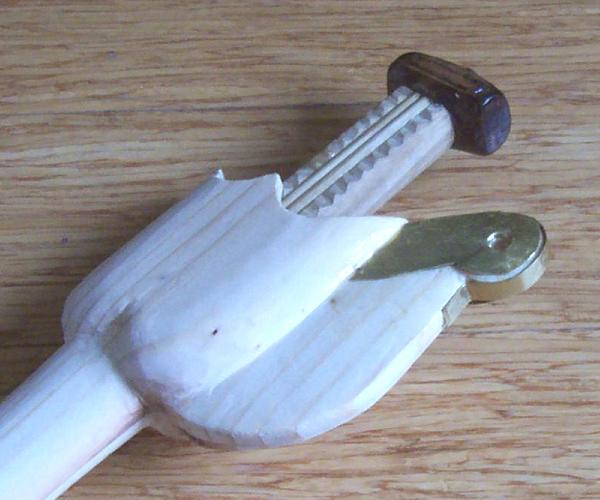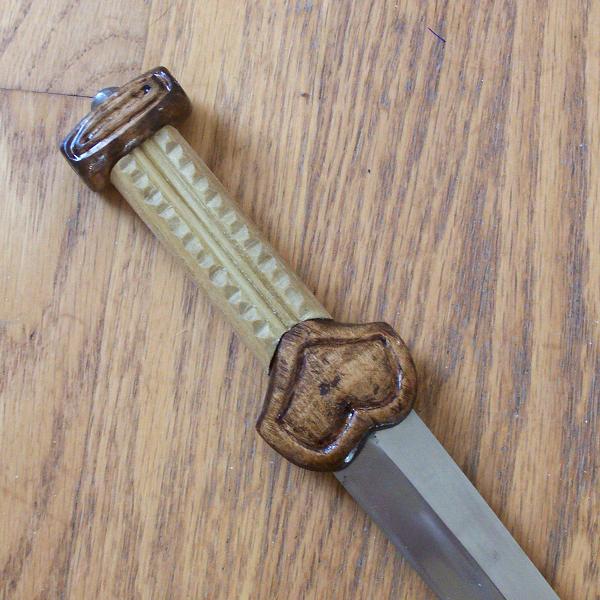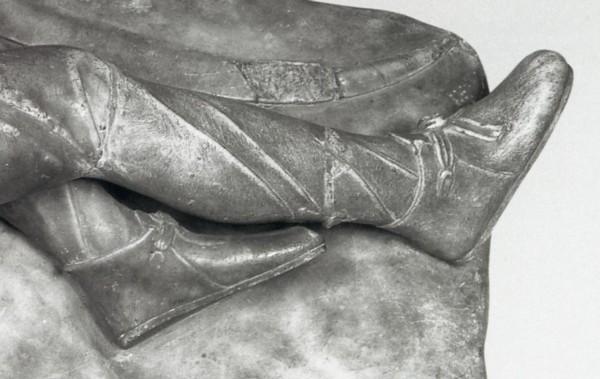Next up is finishing the tab. Drilling a large enough hole for the attachment is simple enough. But since the little ear where the suspension is actually attached looks like a weak point to me, and furthermore pine is a rather weak wood to begin with, I'm trying to reinforce it, using sheet brass and epoxy. I don't know of any evidence for this sort of feature; probably the originals were made of a stronger wood. But it'll be covered with something (probably leather).
The chape is proving problematic. The originals were most commonly made of bronze and sometimes bone. Since I can't cast bronze yet and am having trouble finding a useable lump of bone (it should probably be made of the knuckle end of a cow, sheep or goat leg bone) here I'm using wood as a stopgap measure. Wood is only this side of allowable on the precedent of the scabbard from Egypt, and it should be replaced presently.
Again it's the very common goat motif, though others are sometimes attested. Unfortunately, what I thought was maple has turned out to be something quite a bit softer and more open-grained, also of less uniform hardness, so this carving is cruder than I'd like. I'll probably attach it with rubber cement so it can be easily pulled off when the time comes. A good friction fit will do most of the job, but a little adhesive is necessary, as I learned by nearly losing my pewter chape in the sand at Marathon 2011.
A guide to the Achaemenid Persian empire for reenactors, focusing on the Graeco-Persian Wars period. A quick guide to Persian history, society, religion, military, clothing and culture, plus links to reenactment groups and commemorations of the 2,500th anniversary of the Graeco-Persian Wars.
Sunday, November 16, 2014
Friday, November 7, 2014
Just to pass the time
Since I'm at a standstill on my new akinakes scabbard until I can figure out whether to cover it in leather, parchment or linen, I redid the hilt yet again.
The new grip is made from a one-inch dowel of some very pale, soft and lightweight wood, probably poplar, which is almost certainly not a great choice but was all I had on hand. If it breaks, I can always go back to the old one. It's finished with linseed oil. And yes, it is slightly askew.
It occurs to me that Persian (aka English) walnut would be a good material for small carvings like this.
The pommel and guard are the same scrap maple ones it's had from the beginning, with a modern polyurethane sealer. The grip and guard are based on those seen at Persepolis (check out the last picture on this page). The pyramidal pattern is actually very easy to make with a straight chisel blade on your art knife once all the long grooves have been filed.
Since the akinakes guards are always hidden inside the scabbard throats, I copied the rimmed edge of the guard from one seen on the golden-hilted iron sword here. It's probably Scythian, but the grip and overall shape are not unlike Achaemenid examples.
The securing nut is also further ground down and partially sunken. It's still rather protrusive, but no longer resembles a nut so much as a small, shapeless lump.
The new grip is made from a one-inch dowel of some very pale, soft and lightweight wood, probably poplar, which is almost certainly not a great choice but was all I had on hand. If it breaks, I can always go back to the old one. It's finished with linseed oil. And yes, it is slightly askew.
It occurs to me that Persian (aka English) walnut would be a good material for small carvings like this.
The pommel and guard are the same scrap maple ones it's had from the beginning, with a modern polyurethane sealer. The grip and guard are based on those seen at Persepolis (check out the last picture on this page). The pyramidal pattern is actually very easy to make with a straight chisel blade on your art knife once all the long grooves have been filed.
Since the akinakes guards are always hidden inside the scabbard throats, I copied the rimmed edge of the guard from one seen on the golden-hilted iron sword here. It's probably Scythian, but the grip and overall shape are not unlike Achaemenid examples.
The securing nut is also further ground down and partially sunken. It's still rather protrusive, but no longer resembles a nut so much as a small, shapeless lump.
Saturday, November 1, 2014
Leather and shoes, further updates
I've been in a lengthy and very informative discussion about leathers over at RAT, and it seems that grained leather may be on the table again. This is not inconsistent, since what I've read from brain-tanners is only that it's not easy to get the same softness from a hide without scraping the grain off; they never said it was impossible. Member Ivor (Crispianus) brought to my attention two things I found surprising: a modern repro of an Iron Age shoe, tanned with fish oil with the outer grain intact, and a detail from a piece of Hellenistic statuary showing a pair of Iranian shoes from the side.
It is a scan from Skulpter des Hellenismus. It shows that the ankle shoe in this period was made not from a one-piece upper (a la the Plains moccasins and Hedeby shoes I'd been using as a model), but from a separate vamp and quarter. This allows the quarter to rise as high or low as you like, whereas a one-piece upper has to have extensions sewn on if more than a certain height is desired.
(It further means that the Minnetonka moccasin boots are less inaccurate than I thought, and with a little modification, are actually the only off-the-shelf shoes I've seen that are anything like acceptable. I managed to pull the heels off mine recently, but since they only appear to be available in soft sole now, you could just glue or tunnel-stitch your own leather/rawhide soles without having to potentially rip the bottoms up.)
For comparison, I went searching for high-res pictures of the Alexander Sarcophagus, which is one of the best sources for Persian clothing at the transition of the Achaemenid and Hellenistic periods. In the restored-color versions by Vinzenze Brinkmann and Ulrike Koch-Brinkmann, the straps appear to encircle the ankle like those on Median shoes on the reliefs at Persepolis, but without the "branches" going down the sides. However, there is an extreme closeup over at Wikipedia which appears to show a faint vertical ridge on the central figure's shoe.
With regards to the Persepolis reliefs, Ivor pointed out that the vertical branches could easily be interpreted as strips of reinforcement running down the front edges of the quarter. The ankle strap itself - as he demonstrated by sewing an example - was probably just stitched to the top edge of the quarter rather than running through slits (as per moccasins).
The later example above is slightly modified, with the lace running through a single pair of eyelets, essentially making it a very simple chukka. In this configuration, the eyelets are under much more stress than in the first, since they are pulled forward to hold the top around the ankle, whereas when running the thong around the ankle (either through slits or sewing it on) doesn't pull the shoe leather, but merely squeezes it against the ankle, like a drawstring. Therefore, the later configuration would do well to have a reinforced eyelet.
It is a scan from Skulpter des Hellenismus. It shows that the ankle shoe in this period was made not from a one-piece upper (a la the Plains moccasins and Hedeby shoes I'd been using as a model), but from a separate vamp and quarter. This allows the quarter to rise as high or low as you like, whereas a one-piece upper has to have extensions sewn on if more than a certain height is desired.
(It further means that the Minnetonka moccasin boots are less inaccurate than I thought, and with a little modification, are actually the only off-the-shelf shoes I've seen that are anything like acceptable. I managed to pull the heels off mine recently, but since they only appear to be available in soft sole now, you could just glue or tunnel-stitch your own leather/rawhide soles without having to potentially rip the bottoms up.)
For comparison, I went searching for high-res pictures of the Alexander Sarcophagus, which is one of the best sources for Persian clothing at the transition of the Achaemenid and Hellenistic periods. In the restored-color versions by Vinzenze Brinkmann and Ulrike Koch-Brinkmann, the straps appear to encircle the ankle like those on Median shoes on the reliefs at Persepolis, but without the "branches" going down the sides. However, there is an extreme closeup over at Wikipedia which appears to show a faint vertical ridge on the central figure's shoe.
With regards to the Persepolis reliefs, Ivor pointed out that the vertical branches could easily be interpreted as strips of reinforcement running down the front edges of the quarter. The ankle strap itself - as he demonstrated by sewing an example - was probably just stitched to the top edge of the quarter rather than running through slits (as per moccasins).
The later example above is slightly modified, with the lace running through a single pair of eyelets, essentially making it a very simple chukka. In this configuration, the eyelets are under much more stress than in the first, since they are pulled forward to hold the top around the ankle, whereas when running the thong around the ankle (either through slits or sewing it on) doesn't pull the shoe leather, but merely squeezes it against the ankle, like a drawstring. Therefore, the later configuration would do well to have a reinforced eyelet.
Subscribe to:
Posts (Atom)





